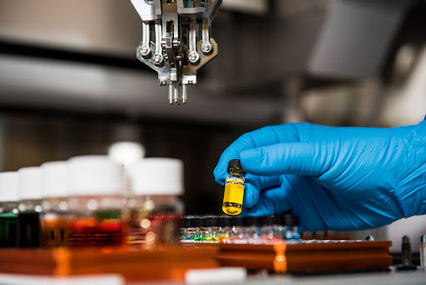When it comes to disposable glove materials, nitrile is one of the most common. But what, exactly, is nitrile? What is it made of and what are its characteristics? And why are disposable nitrile gloves so popular in comparison to other types of gloves like latex or vinyl? Don’t worry - we’ve got all the answers you need when it comes to disposable nitrile gloves.
What Is Nitrile?
Believe it or not, nitrile is a form of rubber. Its full name, nitrile butadiene rubber, classifies it technically as a type of latex. Yet unlike traditional latex, nitrile doesn’t have any traditional latex - or latex proteins - in it. Instead, it’s a completely synthetic version that makes it ideal for anyone who can’t wear traditional rubber latex gloves because of latex skin allergies.
The process for creating nitrile is chemically complex, as it involves mixing two synthetic rubber polymers together. These two copolymers, known as acrylonitrile and butadiene, are mixed, blended, and stabilized in order to create a thin, elastic synthetic latex that is then shaped into nitrile gloves.
What Are Nitrile Gloves Made From?
Nitrile gloves are made from a synthetic rubber called nitrile butadiene rubber (NBR). This material is a copolymer derived from acrylonitrile and butadiene, which are the primary components. The manufacturing process involves polymerizing these two compounds to create a durable and flexible material. This synthetic rubber offers superior resistance to chemicals, oils, and punctures compared to natural rubber latex, making it an ideal choice for various industries, including medical, automotive, and food processing.
The production of nitrile gloves involves several stages, including compounding, dipping, and curing. Initially, the raw materials are mixed with additives to enhance their properties, such as strength and elasticity. The mixture is then formed into gloves by dipping ceramic or aluminum hand molds into the nitrile compound. After dipping, the gloves undergo a curing process, which involves heating to stabilize the material and ensure durability. This process results in a final product that provides excellent protection, comfort, and tactile sensitivity for users, making nitrile gloves a popular alternative to latex and vinyl gloves.
Why Create a Synthetic Latex Material?
There are a number of reasons why nitrile, and nitrile gloves in particular, were developed. First and foremost there is the allergy problem; a significant percentage of people who would otherwise wear latex gloves as part of their everyday jobs simply couldn’t because of latex skin allergies. This meant they had the unenviable choice of either wearing gloves made from different materials that didn’t provide the same capabilities of latex or risk discomfort and pain through allergic reactions.
There are more reasons why nitrile gloves are a better choice than one made with natural rubber or latex materials, though. Nitrile gloves have a higher resistance to acids and oils than those made from natural latex, which makes them advantageous when people are in situations where they may be exposed to such material. Nitrile gloves are also naturally abrasion and puncture resistant as well, which adds even more protection to the wearer. Finally, nitrile gloves, even disposable nitrile gloves, provide high levels of tactile sensitivity and conform very well to the hand - sometimes even better than a natural latex glove.
Uses for Nitrile Gloves
When it comes to nitrile gloves, they can be used in an almost unlimited number of ways and across dozens, if not hundreds, of professions. In fact, thanks to the nature of these gloves, nitrile has often become the first choice for many professionals throughout the globe. Nitrile gloves are often used in the following ways, though this is certainly not a complete list:
- The medical industry loves this material, as it provides great protection against contamination and better durability than latex.
- Scientists handling caustic or dangerous materials rely on these gloves to ensure they have enough dexterity to handle samples safely.
- Tattoo artists and body piercers use these gloves to keep their customers safe and healthy while performing body modifications.
- Food service professionals use nitrile gloves as the material can be made food-safe, making these gloves an excellent choice for preparing, handling, and serving food.
- Hairdressers often wear these gloves while dyeing or treating customers’ hair to protect themselves from hair chemicals and to provide a sterile environment for their customers.
- Auto mechanics and other tradesmen use nitrile gloves to protect themselves from grease, oil, and other related damage while working on engines, transmissions, and other components.
- While Carpenters and construction workers don’t use disposable nitrile gloves very often, many wear cloth or canvas safety gloves coated in nitrile to provide an extra layer of protection and grip while on the job.
Disposing of Nitrile Gloves
Since a nitrile glove is created through a synthetic process, many may think that these types of gloves may not be as easy to dispose of as a traditional latex glove or one made from a different type of material. While it is true that nitrile is much more durable than traditional latex, a nitrile glove is indeed biodegradable, just like its traditional latex cousin. This process does take longer than natural latex, however, due to the synthetic nature of this latex.
At the same time, nitrile gloves have an advantage over latex in that they can be recycled, whereas a typical latex glove cannot. Recycling nitrile gloves isn’t as easy as typical consumer recyclables, though. Instead, nitrile glove manufacturers have programs where they offer collection and return services for their own personal protective equipment made out of recyclable materials (including nitrile) so that this equipment can be recycled properly.
The Best of Both Worlds
The nitrile glove was relatively rare at first after they were originally developed. This scarcity was due to manufacturing costs being relatively high compared to traditional latex, and this cost was often passed along to the consumer. As a result, when nitrile first came onto the market, these gloves, despite how they tended to be of higher quality than latex, were often used sparingly and often only for individuals who needed a hypoallergenic glove option.
Today, by comparison, nitrile gloves are much more common. New manufacturing techniques have reduced the cost of making nitrile, which has made it a competitive choice. Now, the fact that individuals can wear nitrile when they can’t wear latex is just another perk next to nitrile’s increased durability, its versatility, and its ability to be recycled and reused. As a result, nitrile has become increasingly popular across multiple industries.
Will nitrile ever completely replace traditional latex? Most likely not. Will it continue to provide the best of both worlds for a long time to come? It’s almost certain. Nitrile is here to stay!




